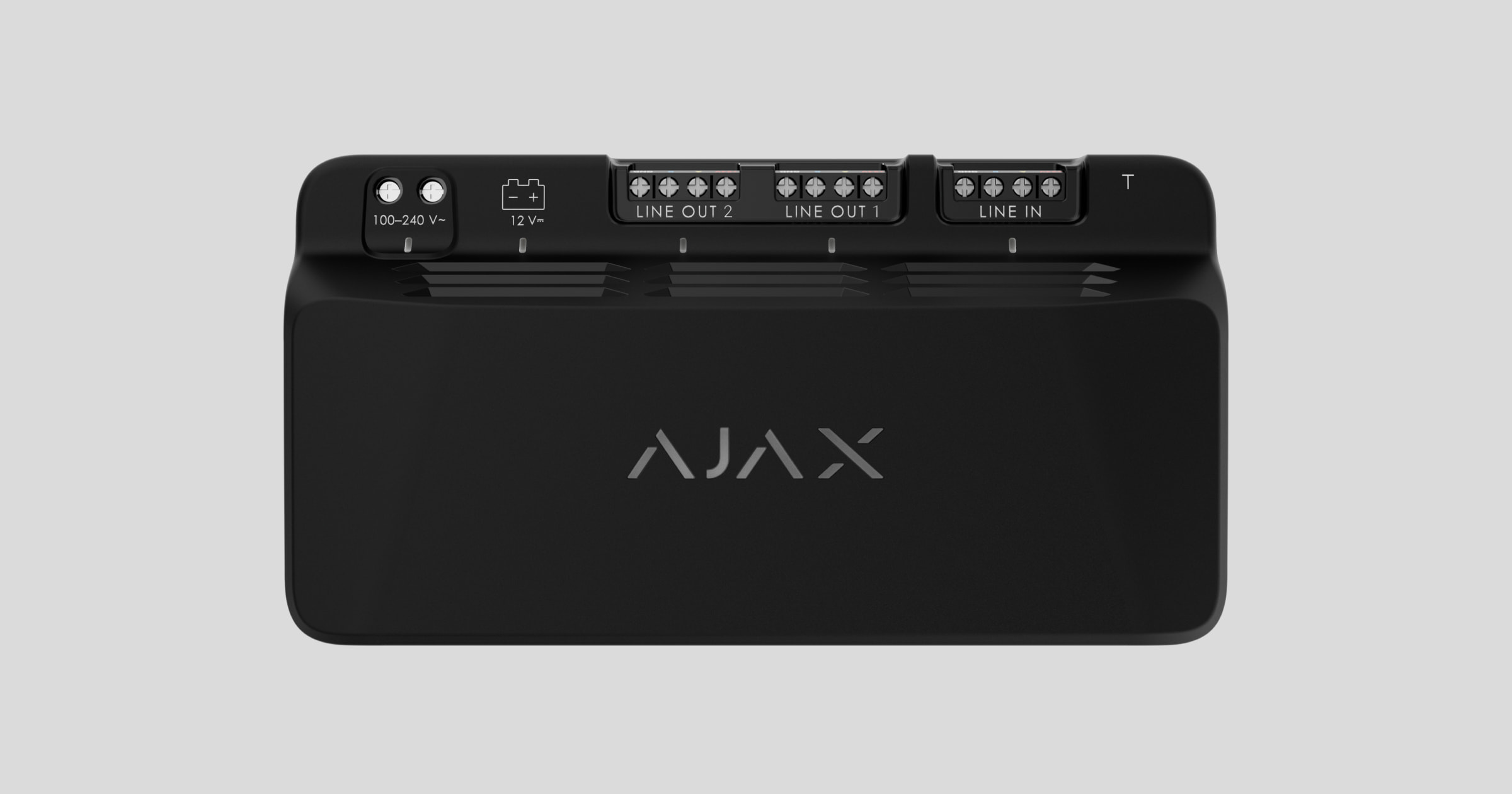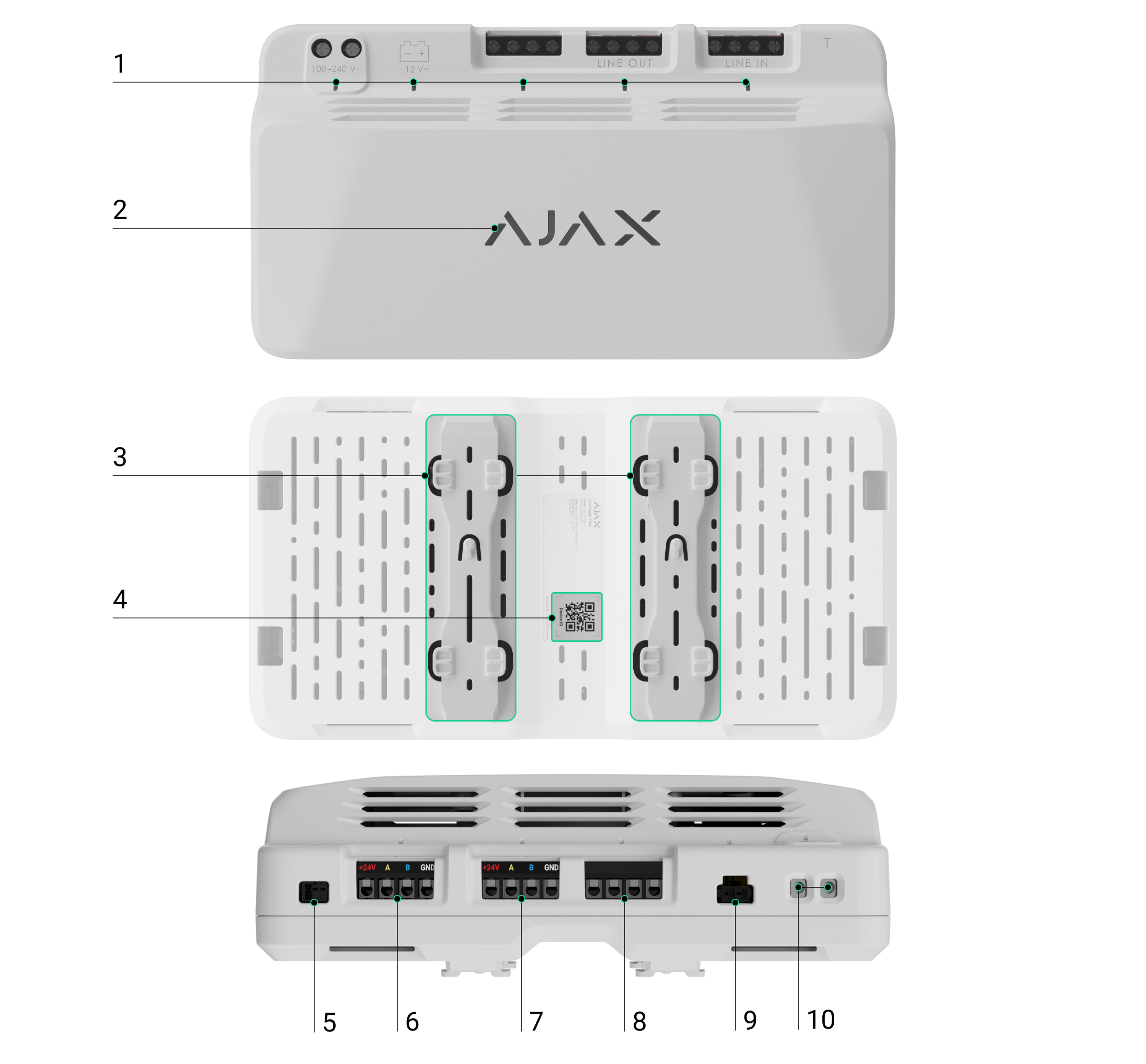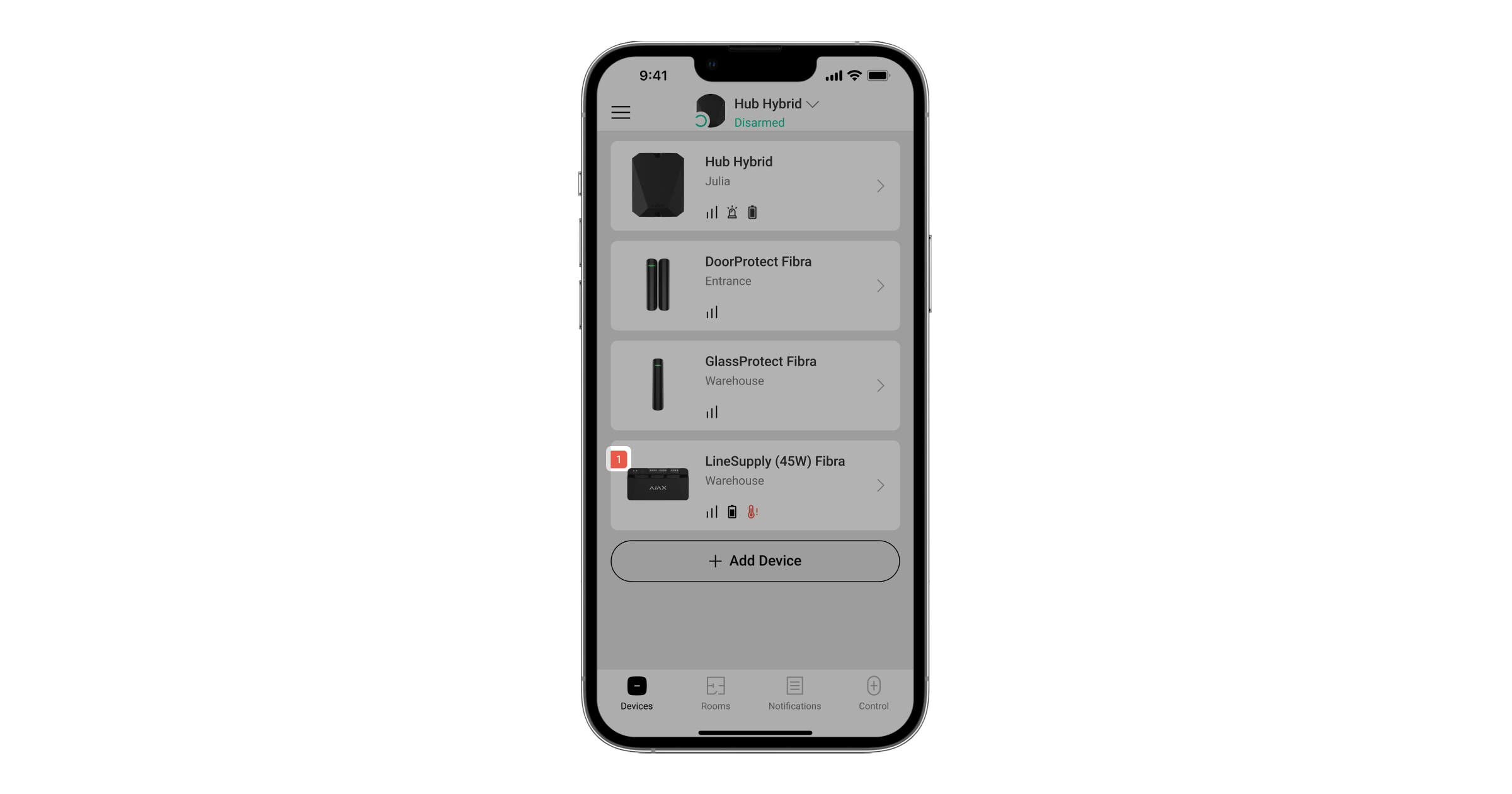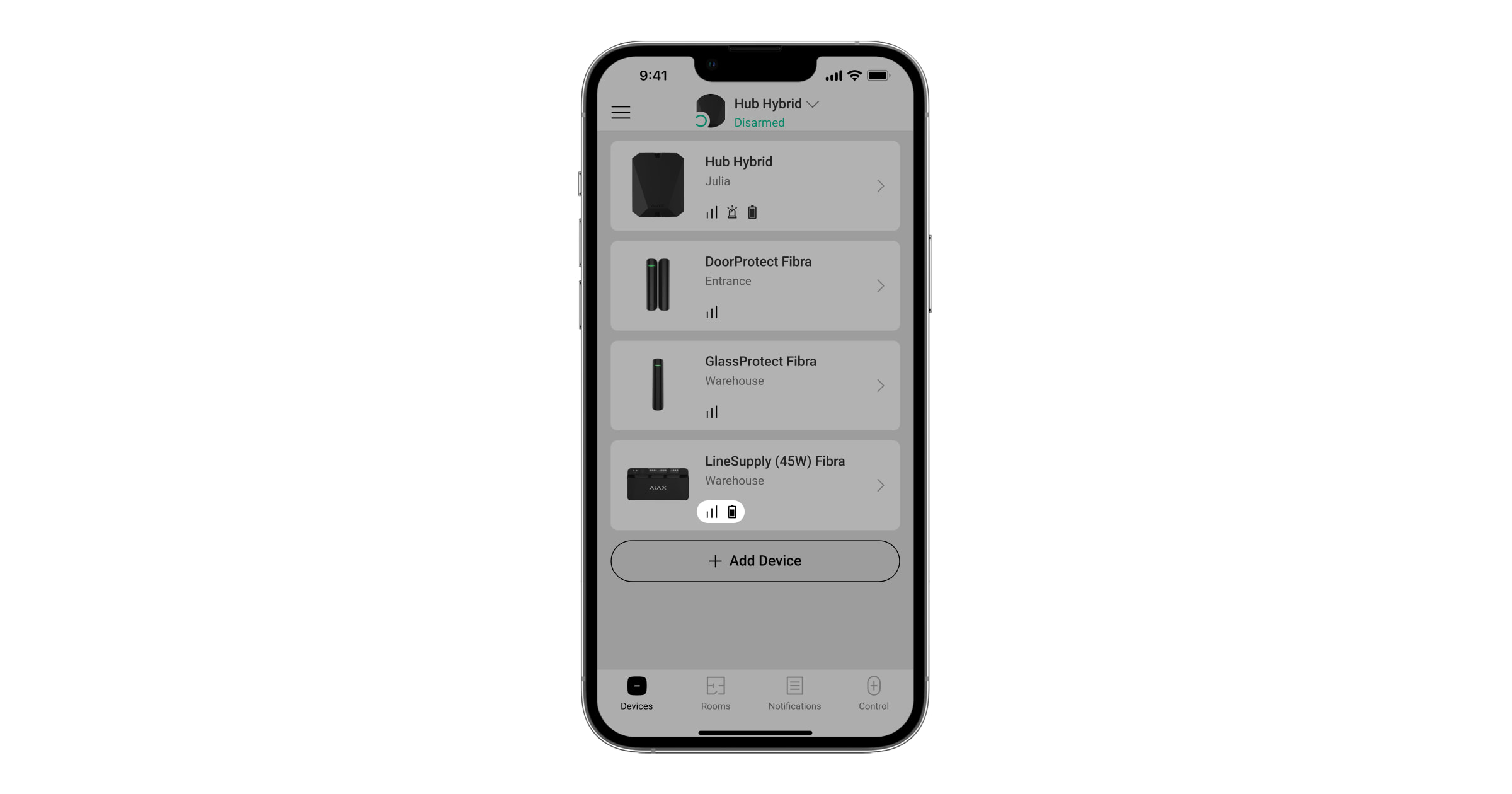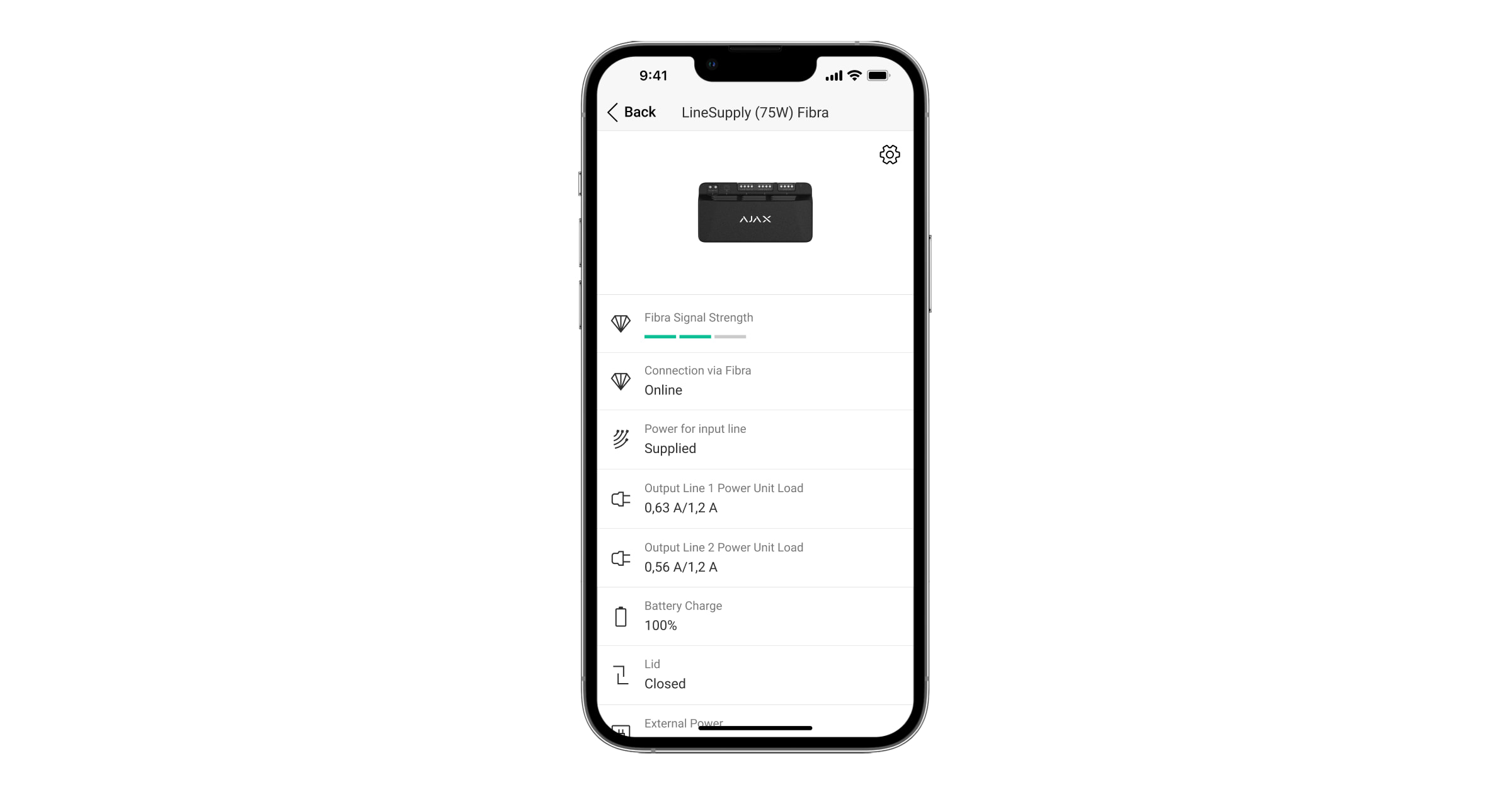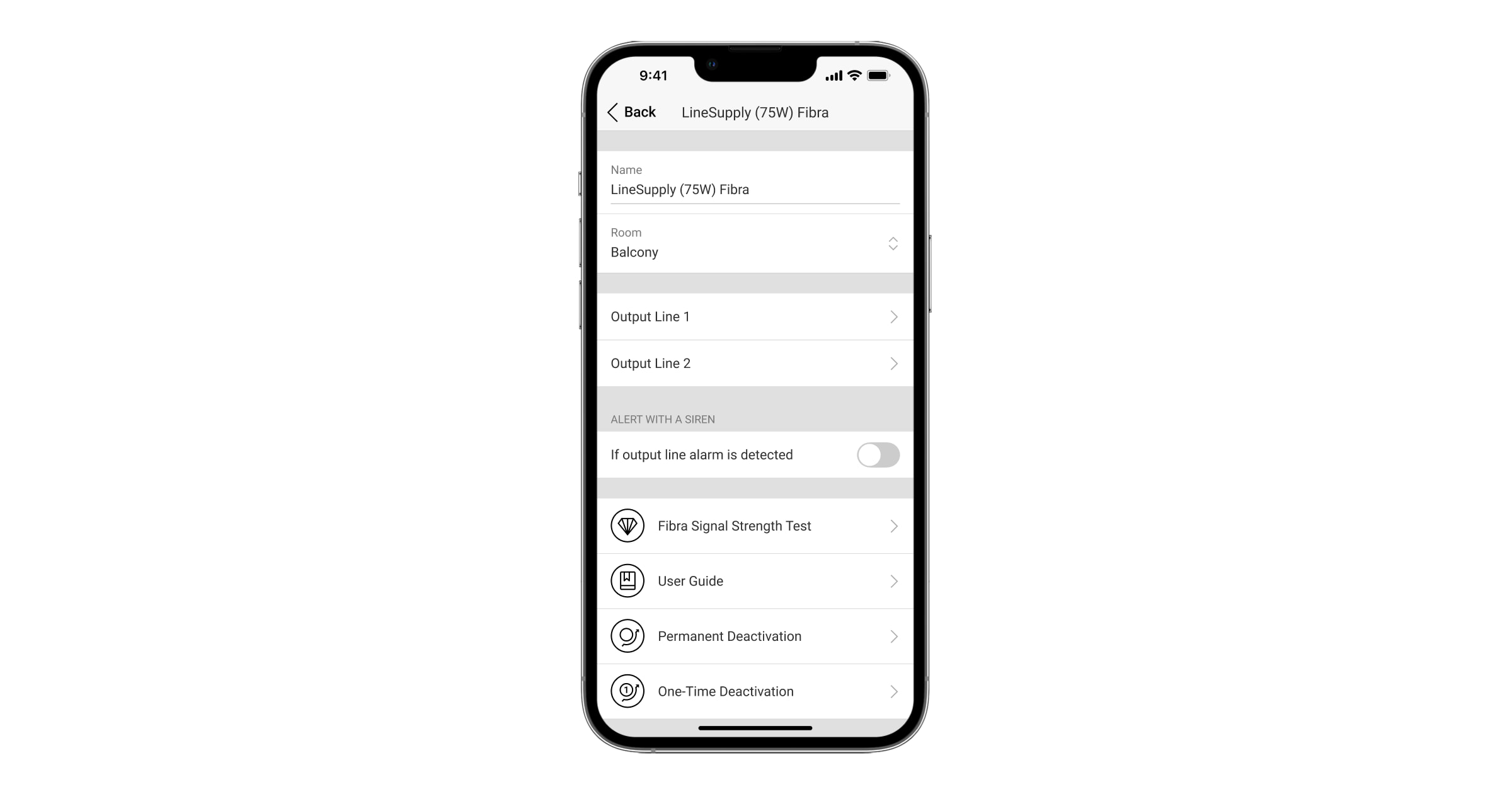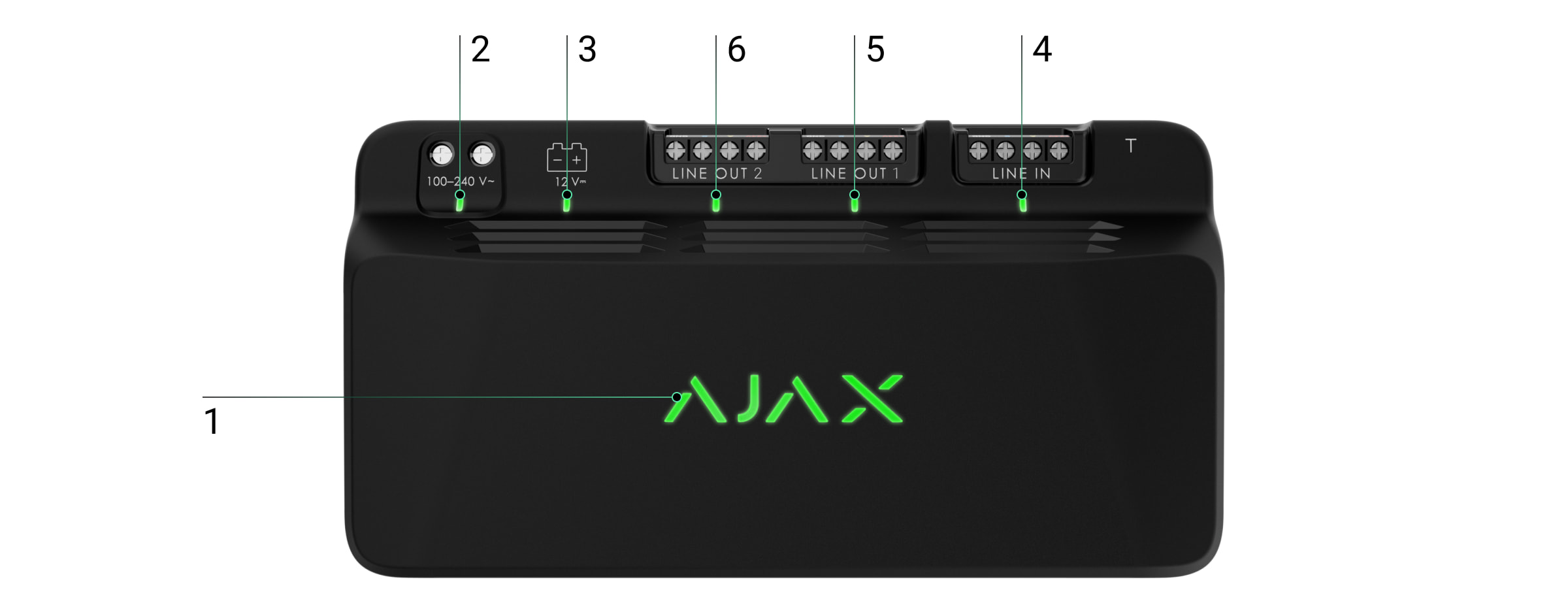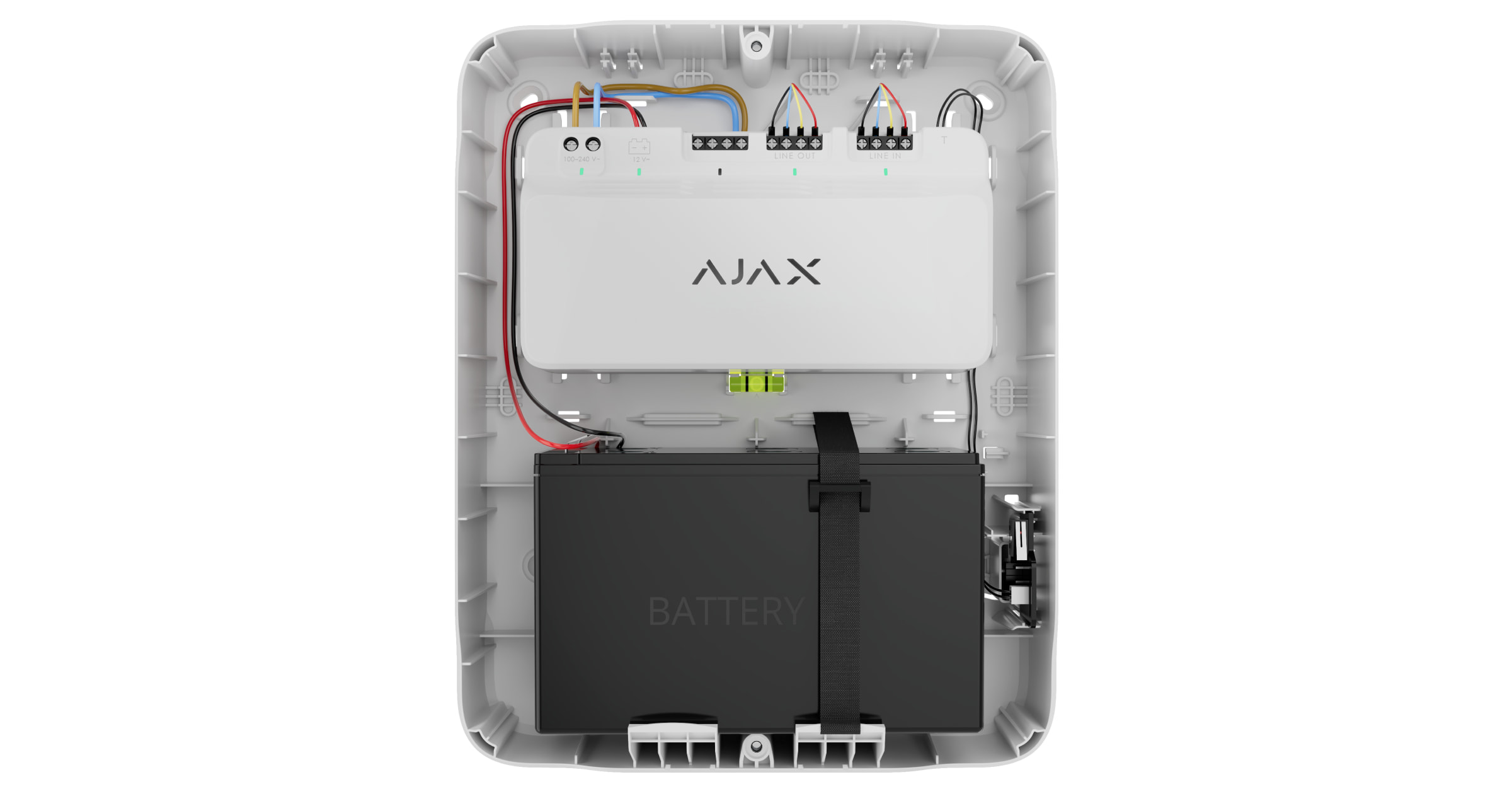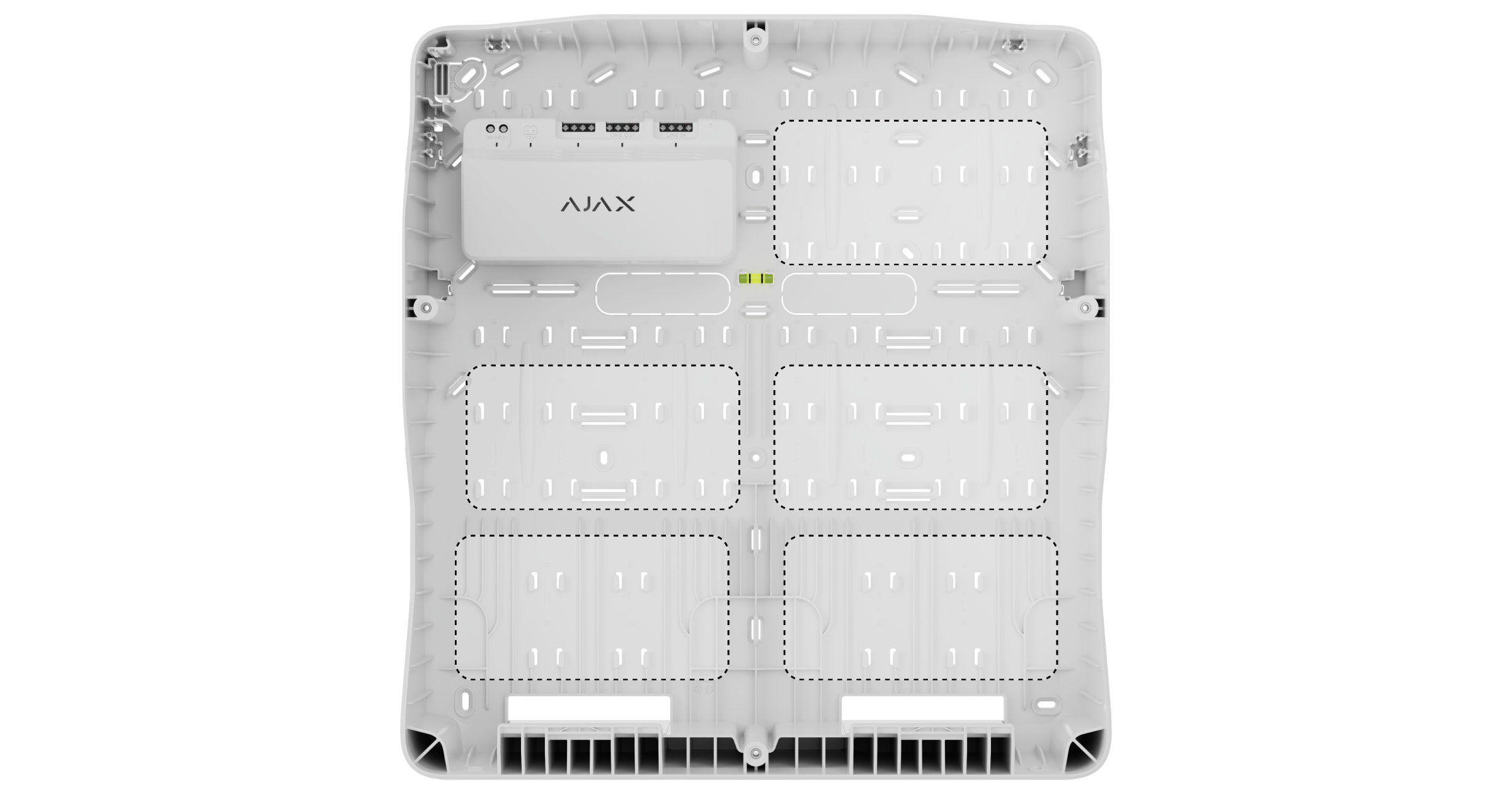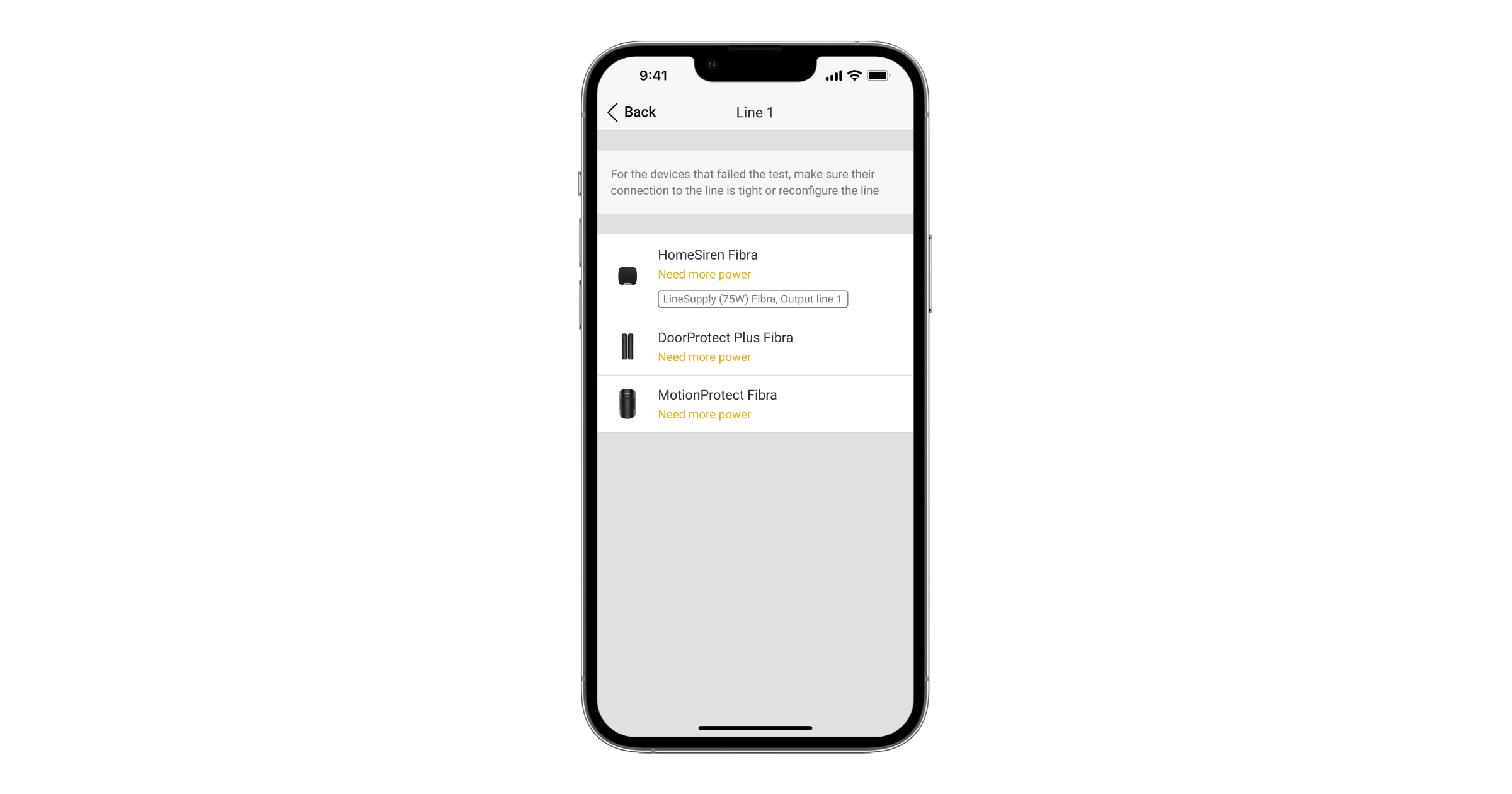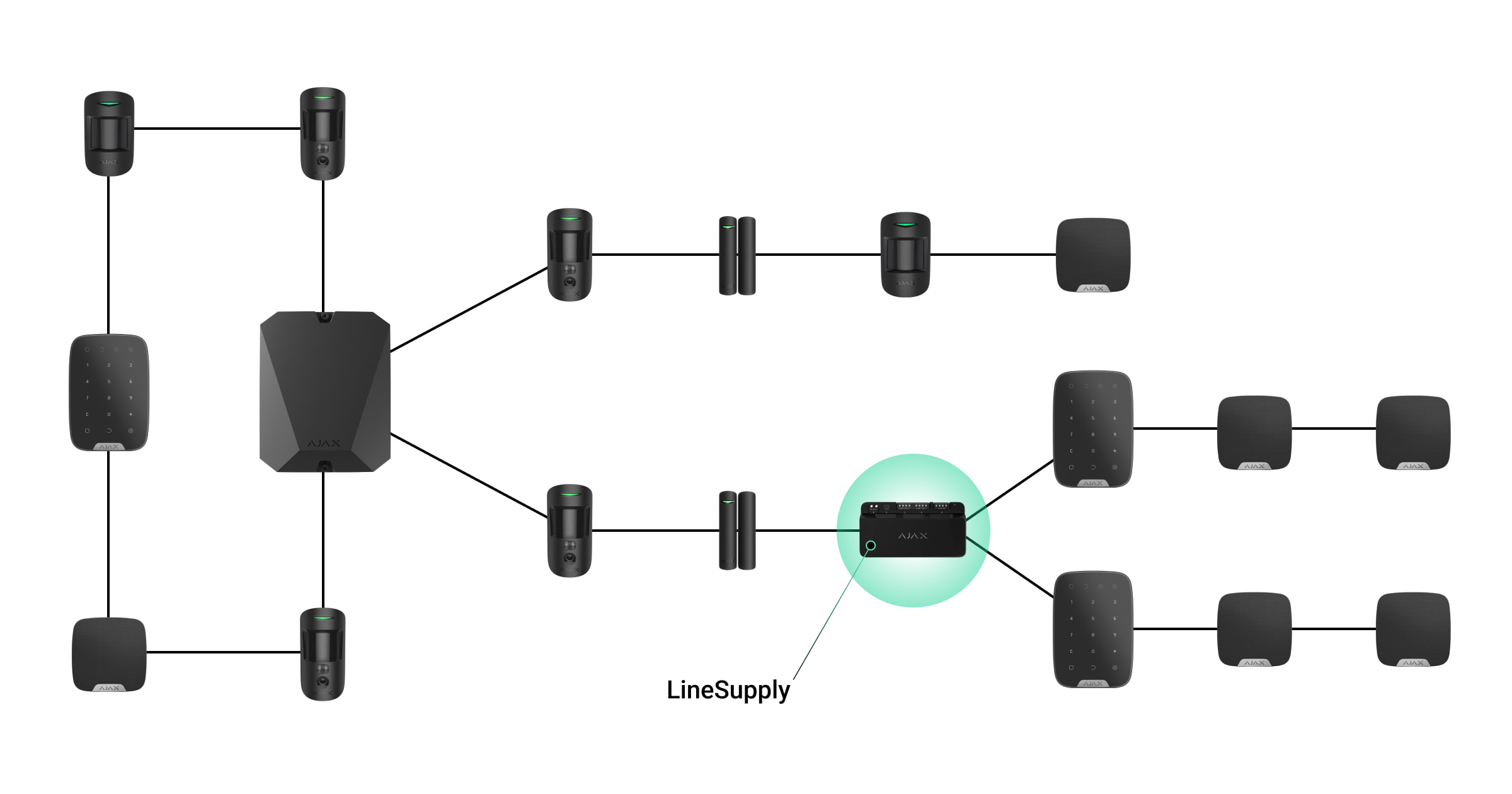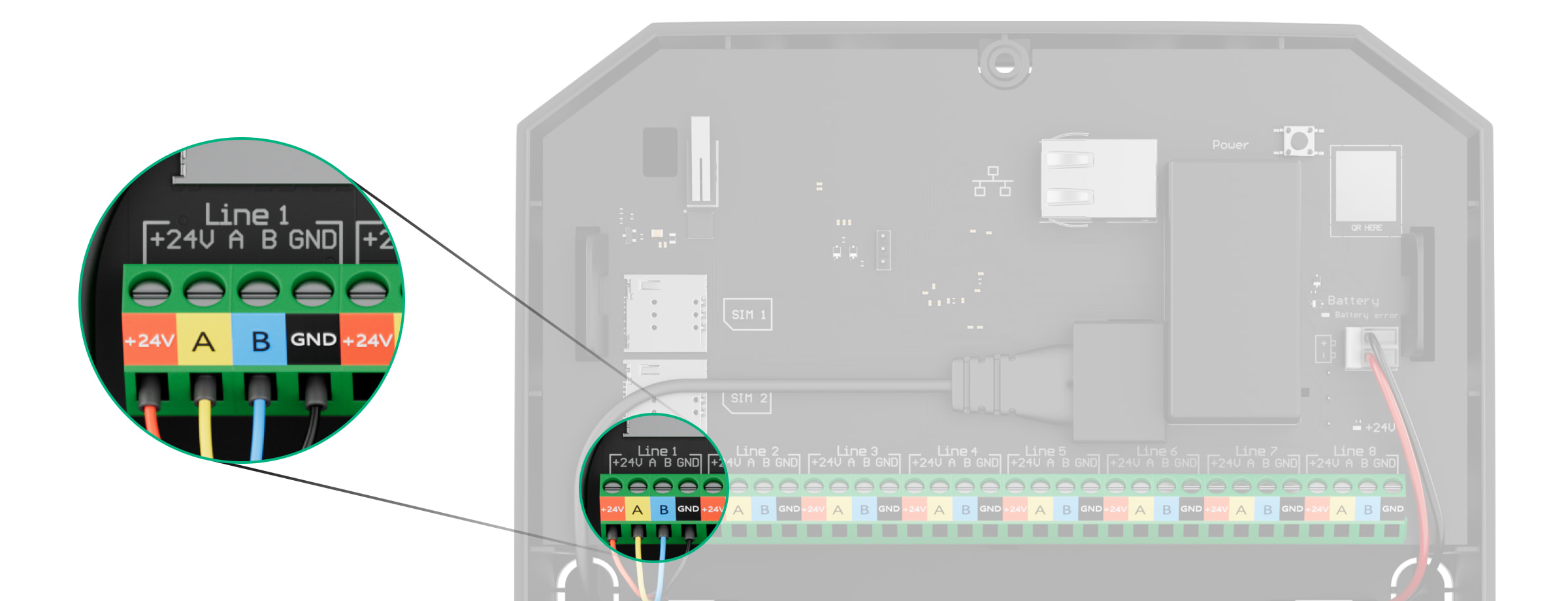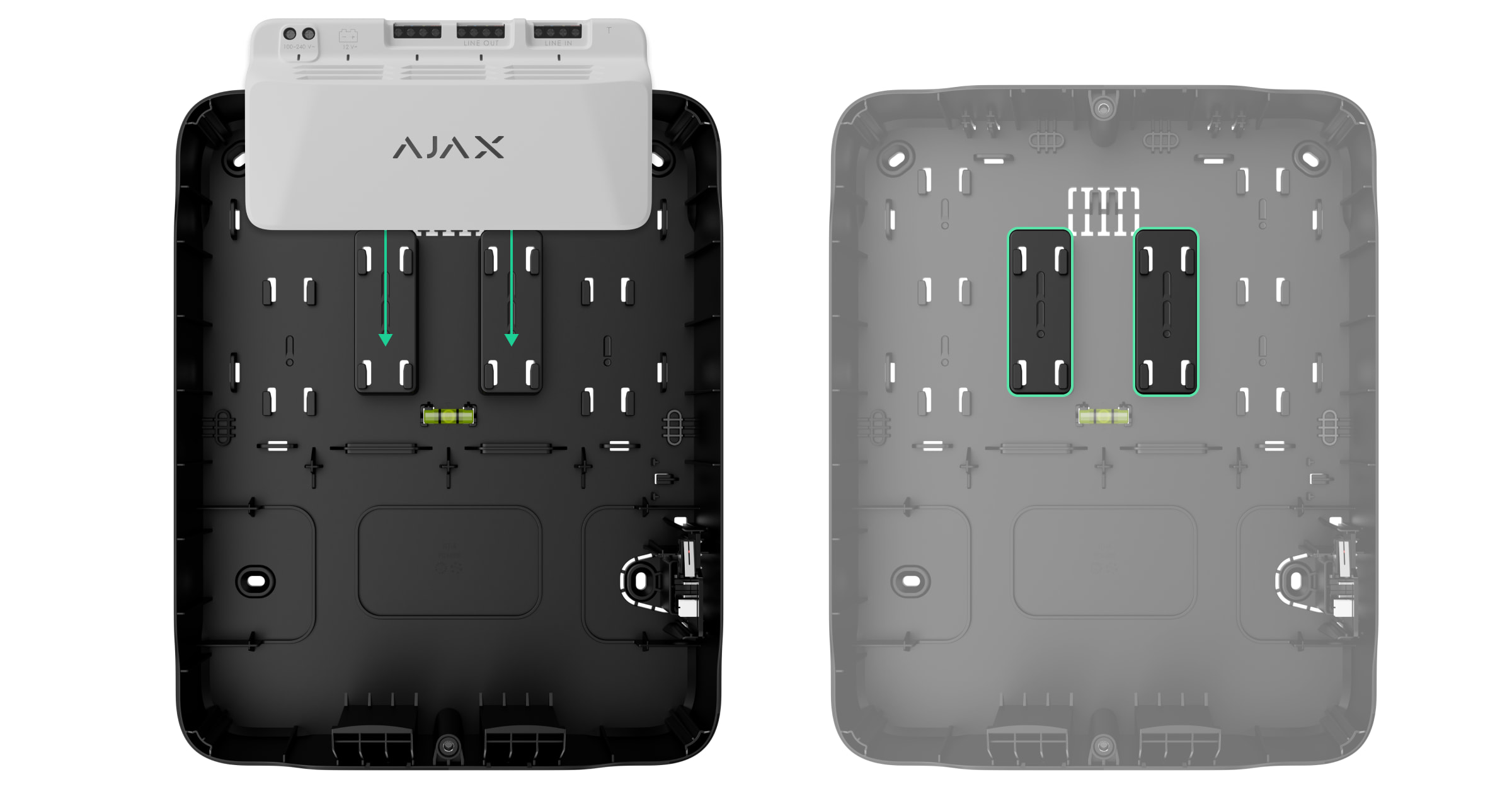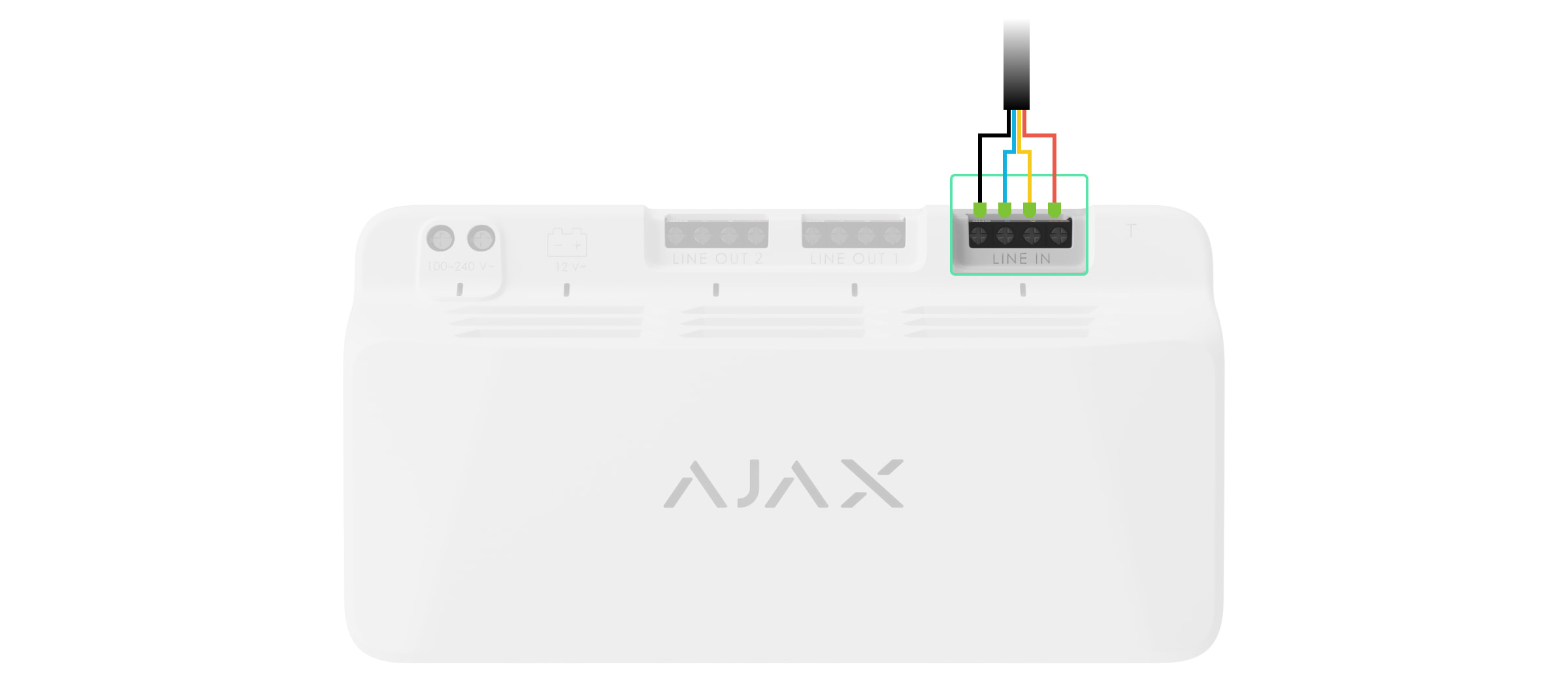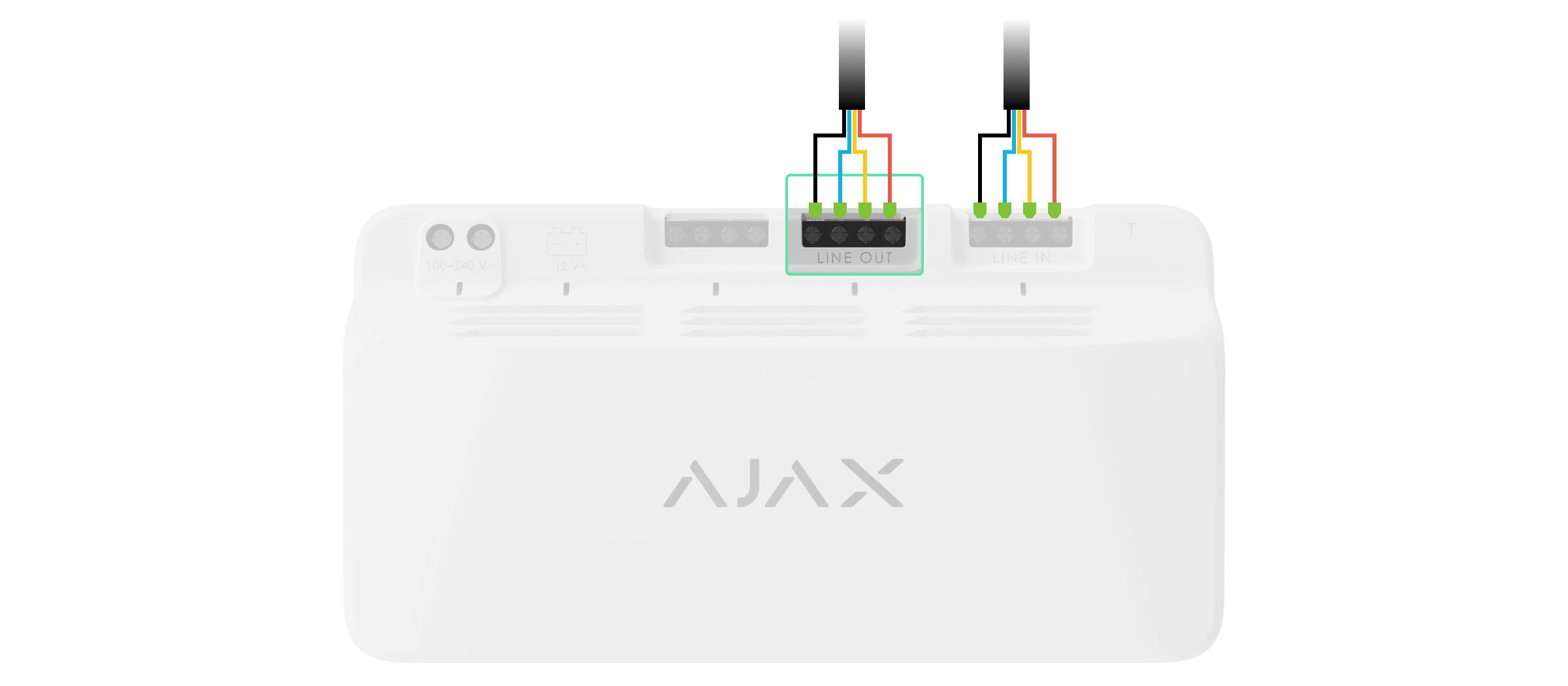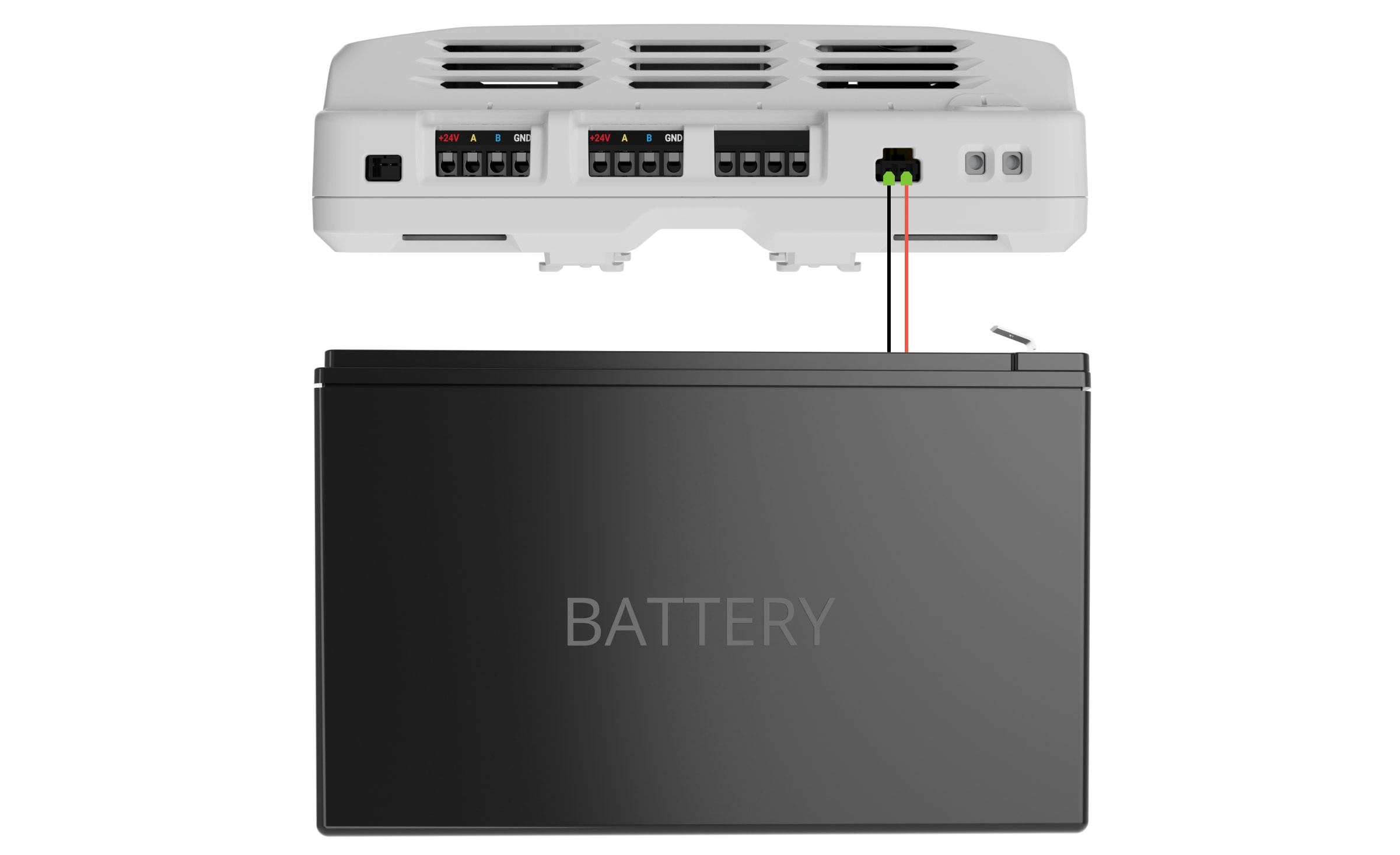Superior LineSupply Fibra é um módulo para a alimentação adicional de dispositivos na linha Fibra. O módulo está disponível em duas versões: Superior LineSupply (45 W) Fibra com uma potência de saída de até 45 W, e Superior LineSupply (75 W) Fibra com uma potência de saída de até 75 W.
O módulo funciona no sistema Ajax e troca dados com o hub utilizando o protocolo seguro de comunicação com fio Fibra.
O dispositivo é compatível com Superior Hub Hybrid (2G) e Superior Hub Hybrid (4G). Não está prevista a ligação a outros hubs, repetidores de sinal de rádio, ocBridge Plus e uartBridge.
Superior LineSupply é parte da linha de produtos Fibra de dispositivos com fios. Apenas os parceiros acreditados da Ajax Systems podem instalar, vender e administrar estes dispositivos.
Elementos funcionais
- Indicadores LED do módulo.
- Logótipo Ajax com um indicador LED.
- Calhas para instalar o Superior LineSupply dentro de uma Case compatível (a carcaça é vendida separadamente).
- Código QR com o ID do dispositivo para adicionar o módulo a um sistema Ajax.
- Conector para fixar a placa de tamper ao módulo. A placa de tamper está incluída no conjunto completo da Case, vendida separadamente.
- Terminais de entrada para a ligação da linha Fibra ao Superior LineSupply.
- Linha de saída com terminais para ligar dispositivos com fios.
- Terminais não utilizados nesta versão do módulo. Na linha Superior LineSupply (75 W), estas servem como uma segunda linha de saída para conectar dispositivos com fio.
- Conector para ligação de uma bateria de reserva de 12 V⎓, 7–18 Ah.
- Terminais para ligação de uma fonte de alimentação de 100–240 V~.
Princípio do funcionamento
Superior LineSupply Fibra é um módulo para a alimentação elétrica adicional de dispositivos na linha Fibra. É possível ligar o Superior LineSupply em qualquer ponto da linha, mesmo depois de outro Superior LineSupply.
O Superior LineSupply (45 W) dispõe de uma linha de saída, enquanto o Superior LineSupply (75 W) dispõe de duas linhas de saída para ligar dispositivos com fios. O número máximo de dispositivos que podem ser ligados ao módulo é determinado pelo hub (100 dispositivos para o Hub Hybrid com definições padrão) e pela potência de saída do Superior LineSupply.
A potência de saída do módulo é distribuída entre os dispositivos ligados e a bateria de reserva. Para o Superior LineSupply (45 W), a distribuição é de 30 W para os dispositivos e 15 W para a bateria de reserva; para o Superior LineSupply (75 W) é de 30 W para cada linha de saída e 15 W para o carregamento da bateria.
O módulo possui proteção contra curto-circuitos e sobretensões nas linhas de saída Fibra. Em caso de curto-circuito ou sobretensão, o Superior LineSupply desliga a linha de saída afetada e tenta restabelecer a alimentação após 12 segundos. Se o problema persistir, o módulo desliga a linha novamente, repetindo este processo até que a operação normal seja restaurada.
O Superior LineSupply identifica o tipo de avaria e o sistema envia a notificação correspondente para as aplicações Ajax.
Protocolo de transferência de dados Fibra
O módulo utiliza a tecnologia Fibra para transmitir alarmes e eventos. É um protocolo de transferência de dados com fios para uma comunicação bidirecional rápida e fiável entre o hub e os dispositivos conectados.
Envio de eventos para a central de monitorização
O sistema Ajax pode transmitir alarmes tanto para a app de monitorização PRO Desktop como para a central recetora de alarmes (CRA) nos formatos SurGard (Contact ID), SIA (DC-09), ADEMCO 685, e outros protocolos.
Superior LineSupply pode transmitir os seguintes eventos:
- Alarme de tamper e recuperação; o módulo possui um conector para conectar uma placa de tamper, inclusa no conjunto completo da carcaça.
- Ligação/desligação da placa de tamper.
- Deteção de baixa tensão na linha de saída do módulo e reposição da tensão nos valores normais.
- Deteção de curto-circuito na linha Fibra e restabelecimento da alimentação elétrica.
- Deteção de sobretensão nas linhas de sinal de saída do módulo e reposição da tensão nos valores normais.
- Ligação/desligação da bateria de reserva ao módulo.
- Carga baixa da bateria de reserva e restauro da carga da bateria.
- Avaria/restauro da bateria de reserva.
- Perda/restauração da alimentação elétrica principal.
- Perda/restauração de conexão entre a Superior LineSupply e o hub.
- A alimentação da linha de saída do módulo está desligada/ligada.
- Deteção de avaria; o módulo não consegue carregar a bateria de reserva.
- Desativação/ativação permanente do dispositivo.
- Desativação/ativação única do dispositivo.
- A temperatura do dispositivo está fora dos limites aceitáveis; a temperatura volta aos valores normais.
As informações, incluindo o número da linha em causa, são transmitidas para todos os eventos nas linhas de saída do Superior LineSupply (75 W).
Quando um alarme é recebido, o operador da central de vigilância da empresa de segurança sabe o que aconteceu e sabe exatamente para onde enviar uma equipa de intervenção rápida. A capacidade de endereçamento dos dispositivos Ajax permite enviar eventos para o PRO Desktop ou para a CRA, incluindo o tipo de dispositivo, o seu nome, o grupo de segurança e a sala virtual. A lista de parâmetros transmitidos pode variar consoante o tipo da CRA e o protocolo de comunicação selecionado para a estação de monitorização.
O ID e o número do dispositivo podem ser encontrados nos seus estados na app Ajax.
Adicionar ao sistema
O Superior LineSupply Fibra é compatível apenas com o Superior Hub Hybrid (2G) e Superior Hub Hybrid (4G). Apenas os parceiros verificados podem adicionar e configurar dispositivos Fibra nas apps Ajax PRO.
Antes de adicionar dispositivos
- Instale a app Ajax PRO.
- Inicie sessão numa conta PRO ou crie uma nova conta.
- Selecione um espaço ou crie um novo.
A funcionalidade de espaço está disponível para apps dessas versões ou posteriores:
- Ajax Security System 3.0 para iOS;
- Ajax Security System 3.0 para Android;
- Ajax PRO: Tool for Engineers 2.0 para iOS;
- Ajax PRO: Tool for Engineers 2.0 para Android;
- Ajax PRO Desktop 4.0 para macOS;
- Ajax PRO Desktop 4.0 para Windows.
- Adicione pelo menos uma sala virtual.
- Adicione um hub compatível ao espaço. Certifique-se de que o hub está ligado e tem acesso à Internet através de Ethernet, Wi-Fi e/ou rede móvel.
- Certifique-se de que o espaço está desarmado e de que o hub não está a iniciar uma atualização, verificando os estados na app Ajax.
Ligação ao hub
Estão disponíveis duas formas de adicionar dispositivos na app Ajax PRO: automaticamente e manualmente.
- Abra a app Ajax PRO e selecione o hub ao qual deseja adicionar Superior LineSupply.
- Aceda ao separador Dispositivos
e clique em Adicionar dispositivo.
- Selecione Adicionar todos os dispositivos Fibra. O hub vai analisar as linhas Fibra. Após a verificação, todos os dispositivos ligados ao hub que ainda não foram adicionados ao sistema serão apresentados.
- Selecione o dispositivo desejado da lista. Após a seleção, o indicador LED piscará para identificar este dispositivo.
- Dê um nome ao dispositivo e selecione a sala e o grupo de segurança se o Modo de Grupo estiver ativado. Clique em Guardar.
Se a tentativa de ligação falhar, certifique-se de que a ligação com fios está corretamente configurada antes de tentar novamente. Se o número máximo de dispositivos (100 para o Hub Hybrid) já tiver sido adicionado ao hub, receberá uma notificação de erro ao adicionar.
Uma vez ligado ao hub, o módulo aparecerá na lista de dispositivos do hub na app Ajax. A frequência de atualização do estado do dispositivo na lista depende das definições Jeweller ou Jeweller/Fibra, com o valor predefinido de 36 segundos.
Superior LineSupply funciona apenas com um hub. Quando conectado a um novo hub, o dispositivo para de enviar eventos para o antigo.
Adicionar o módulo a um novo hub não o remove automaticamente da lista de dispositivos do hub antigo. Isto deve ser feito manualmente através da app Ajax.
.
Avarias
Quando é detetada uma avaria no Superior LineSupply, a app Ajax apresenta um contador de avarias no ícone do dispositivo. Todas as avarias são indicadas nos estados do módulo. Os campos com avarias vão ser indicados com vermelho.
Uma avaria é apresentada se:
- a carcaça está destacada da superfície ou a sua integridade foi comprometida;
- curto-circuito na linha Fibra;
- sobretensão nas linhas de sinal de saída do módulo;
- baixa tensão na linha de saída;
- a bateria de reserva não está instalada;
- a bateria de reserva não está a funcionar corretamente;
- a bateria de reserva está fraca;
- a fonte de alimentação externa está desligada;
- O módulo Superior LineSupply tem uma avaria e não consegue carregar a bateria de reserva;
- a temperatura do módulo está fora dos limites aceitáveis;
- a conexão com um hub foi perdida.
Se a avaria ocorrer na linha de saída do Superior LineSupply (75 W), a notificação correspondente no historial de eventos do app Ajax possui seu número.
Ícones
Os ícones na app apresentam alguns estados de módulos. Para aceder aos mesmos:
- Inicie sessão na app Ajax.
- Selecione o hub.
- Aceda o separador Dispositivos
.
| Ícone | Valor |
|
Intensidade do sinal Fibra: ecrã a intensidade do sinal entre o hub e o módulo. |
|
| Linha SuperiorNível de carga da bateria de alimentação, em percentagem. | |
| Superior LineSupply o limiar de temperatura foi ultrapassado. | |
| A bateria de reserva está avariada ou não está instalada. | |
|
O Superior LineSupply está permanentemente desativado. |
|
|
As notificações do alarme de tamper de Superior LineSupply estão permanentemente desativadas. |
|
|
Superior LineSupply está desativado até ao primeiro desarme do sistema. |
|
|
As notificações do alarme de tamper do Superior LineSupply ficam desativadas até o primeiro desarmamento do sistema. |
|
| O dispositivo perdeu a ligação com o hub ou o hub perdeu a ligação com o servidor Ajax Cloud. | |
|
O dispositivo não foi transferido para o novo hub. |
Estados
Os estados incluem informações sobre o dispositivo e os seus parâmetros de funcionamento. Pode encontrar os estados do Superior LineSupply nas apps Ajax:
- Aceda o separador Dispositivos
.
- Selecione Superior LineSupply da lista.
| Parâmetro | Valor |
| Importação de dados | Apresenta o erro aquando da transferência de dados para o novo hub:
|
| Avaria |
Clicar em O campo só é apresentado se for detetada uma avaria. |
| Intensidade do sinal Fibra |
Intensidade do sinal Fibra entre o dispositivo e o hub. O valor recomendado é de 2–3 barras. Fibra é um protocolo para a transmissão de eventos e alarmes do Superior LineSupply. |
| Conexão via Fibra | Estado da ligação no canal Fibra entre o dispositivo e o hub:
|
| Alimentação da linha de entrada | Estado da alimentação na linha de entrada:
|
| Carga da Unidade de Potência / Linha de Saída 1 Carga da Unidade de Potência |
A corrente consumida pelos dispositivos Fibra conectados ao módulo. Para Superior LineSupply (75 W), este é o valor para a primeira linha de saída. O módulo pode fornecer até 1,2 A de corrente de saída em cada linha. |
| Carga da Unidade de Potência da Linha de Saída 2 |
A corrente consumida pelos dispositivos Fibra conectados à segunda linha de saída do módulo. O módulo pode fornecer até 1,2 A de corrente de saída em cada linha. Apresentado apenas nos estados do Superior LineSupply (75 W). |
| Carga da bateria | O estado da bateria de reserva:
|
| Tampa | O estado de tamper que responde à separação da carcaça da superfície ou à violação de sua integridade:
|
| Alimentação externa | Estado da ligação da fonte de alimentação externa:
|
| Fonte de alimentação da linha de saída / Fonte de alimentação da linha de saída 1 | Estado da energia na primeira linha de saída do módulo:
|
| Fonte de alimentação da linha de saída 2 | Estado da alimentação na segunda linha de saída do módulo:
Apresentado apenas nos estados do Superior LineSupply (75 W). |
| Desativação Permanente | Mostra o estado da definição de desativação permanente do módulo:
|
| Desativação Única | Apresenta o estado da definição de desativação única do dispositivo:
|
| Firmware | Versão do firmware do dispositivo. |
| ID do dispositivo | ID do módulo. Também disponível no código QR no invólucro do dispositivo e na sua caixa de embalagem. |
| Número do Dispositivo. | Número do bucle do dispositivo (zona). |
| Linha nº. | O número da linha Fibra à qual o Superior LineSupply está ligado. |
Definições
Para alterar as definições do Superior LineSupply nas apps Ajax:
- Aceda o separador Dispositivos
.
- Selecione Superior LineSupply da lista.
- Aceda a Definições clicando no ícone
.
- Defina as definições necessárias.
- Clique em Voltar para guardar as novas definições.
| Definições | Valor |
| Nome |
Nome do módulo. Aparece na lista de dispositivos de hub, texto SMS e notificações no historial de eventos. Para alterar o nome do dispositivo, clique no campo de texto. O nome pode conter até 12 caracteres cirílicos ou até 24 caracteres latinos. |
| Sala |
Seleção da sala virtual à qual é atribuído o Superior LineSupply. O nome da sala aparece no texto do SMS e nas notificações no historial de eventos. |
|
Linha de saída 1/Linha de saída 2 |
|
| Fonte de alimentação da linha de saída |
Esta opção está ativada por defeito, e a linha de saída do módulo está alimentada. Se a opção estiver desativada, a linha de saída não é alimentada. |
| Parar de alimentar a linha se a alimentação elétrica do hub for interrompida | Se estiver ativado e a alimentação de energia do hub for interrompida, o módulo corta a alimentação de energia da linha de saída e dos dispositivos a ela ligados. |
| Alerta com uma sirene em caso de deteção de alarme na linha de saída |
Quando esta opção está ativada, as sirenes adicionadas ao sistema serão ativadas em caso de alarme na linha de saída (curto-circuito ou sobretensão nas linhas de sinal). Esta opção está desativada por defeito. |
| Teste de intensidade de sinal Fibra |
Passa o dispositivo para o modo de teste da intensidade do sinal Fibra. |
| Guia do Utilizador | Abre o manual do utilizador do Superior LineSupply na app Ajax. |
| Desativação Permanente |
Permite ao utilizador desativar o dispositivo sem o retirar do sistema. Estão disponíveis três opções:
|
| Desativação Única |
Permite ao utilizador desativar eventos do dispositivo até ao primeiro desarme. Estão disponíveis três opções:
|
| Eliminar dispositivo | Desemparelha o dispositivo, desliga-o do hub e elimina as suas definições. |
Indicação
O Superior LineSupply está equipado com vários indicadores LED para informar sobre os seus estados:
- O indicador principal.
- Indicador da fonte de alimentação externa do módulo.
- Indicador do estado da bateria de reserva.
- Indicador do estado da ligação da linha de entrada.
- Indicador do estado da alimentação elétrica da linha de saída 1.
- Indicador não utilizado em Superior LineSupply (45 W) Fibra / Indicador do estado de alimentação da linha de saída 2 para Superior LineSupply (75 W) Fibra.
| Indicador | Indicação | Evento |
| Principal |
Ilumina-se a verde. Quando adicionado automaticamente – o LED verde pisca rapidamente quando o Superior LineSupply é selecionado na lista. Quando se clica em Adicionar dispositivo, o LED verde pisca uma vez. Quando adicionado manualmente – o LED verde pisca uma vez. |
Indicação padrão do módulo quando este está a funcionar corretamente. |
| Ilumina-se a vermelho. | AvariaNível baixo da bateriaA vida útil do dispositivo expirou:
|
|
| Estado da ligação da linha de entrada | Ilumina-se a verde. | Quando existe uma fonte de alimentação do hub. |
| Estado da alimentação elétrica da linha de saída 1 | Ilumina-se a verde. | Quando a potência da linha de saída está ligada. |
| Estado da alimentação elétrica da linha de saída 2 |
Está desligado no módulo Superior LineSupply (45 W). Acende-se a verde no módulo Superior LineSupply (75 W). |
Um indicador acende-se no módulo Superior LineSupply (75 W) se a linha de saída estiver a ser alimentada. |
| Estado da bateria de reserva | Ilumina-se a vermelho. | Se a polaridade estiver invertida ao ligar a bateria de reserva. |
| Sem iluminação. | A bateria de reserva não está instalada. | |
| Acende-se permanentemente a verde. | A bateria de reserva está carregada. A fonte de alimentação externa do módulo está ligada. | |
| Pisca uma vez a cada 10 segundos. | A bateria de reserva está carregada. A fonte de alimentação externa do módulo está desligada. | |
| Em caso de alarme, acende-se e apaga-se suavemente uma vez por minuto. | A bateria de reserva está fraca. | |
| Pisca a verde a cada 0,5 segundos. | A bateria de reserva está a carregar. | |
| Estado da fonte de alimentação externa do módulo | Ilumina-se a verde. | Quando a fonte de alimentação externa do módulo está ligada. |
Teste de funcionalidade
O sistema Ajax oferece vários tipos de testes para ajudar a selecionar o local de instalação correto para os dispositivos. O teste não começa imediatamente. No entanto, o tempo de espera não excede a duração de um intervalo de consulta entre o hub e dispositivo. O intervalo de consulta pode ser verificado e configurado nas definições do hub (Hub → Definições → Jeweller/Fibra).
Para executar o teste, na app Ajax:
- Selecione o hub necessário.
- Aceda o separador Dispositivos
.
- Selecione Superior LineSupply da lista.
- Aceda a Definições
.
- Faça o Teste de intensidade do sinal Fibra.
Colocação do dispositivo
Instale o Superior LineSupply na linha antes dos dispositivos Fibra com o maior consumo de energia, que podem carecer de energia do hub. Isso poderia ser dispositivos como sirenes ou teclados, por exemplo. O Superior LineSupply também pode funcionar como um repetidor para alargar o alcance da linha.
Embora possa instalar o módulo mesmo depois de outro Superior LineSupply, evite ligar as linhas de saída Fibra do módulo numa topologia em anel.
Ao escolher um local para o Superior LineSupply, considere os parâmetros que afetam o seu funcionamento:
- Intensidade do sinal Fibra.
- Comprimento do cabo utilizado para ligar o Superior LineSupply.
- Comprimento do cabo que liga os dispositivos com fios ao Superior LineSupply.
Siga estas recomendações ao conceber o projeto de sistema para um objeto. Só os profissionais devem conceber e instalar o sistema Ajax. A lista de parceiros Ajax autorizados está disponível aqui.
Instalação na Case
Para instalar o Superior LineSupply, use Case C (260) ou Case D (430), que são vendidos separadamente. É possível montar um Superior LineSupply na caixa C (260) e vários módulos ou outros dispositivos na caixa D (430). Utilize o configurador de Case para obter a melhor colocação dos seus dispositivos Fibra na carcaça.
Cada carcaça é equipada com suportes para os módulos, canais de fio e um tamper que pode ser conectado ao Superior LineSupply.
Não instalar o Superior LineSupply
- No exterior, pois pode levar à falha do módulo.
- Em locais onde os níveis de temperatura e humidade excedem os limites permitidos, pois isso pode danificar o módulo.
- Em locais com uma intensidade de sinal Fibra baixa ou instável, uma vez que isso pode causar uma perda de ligação com o hub.
Intensidade do sinal Fibra
A intensidade do sinal Fibra é determinada pelo número de pacotes de dados não entregues ou corrompidos durante um determinado período de tempo. O ícone no separador Dispositivos
indica a intensidade do sinal:
- três barras — excelente intensidade de sinal;
- duas barras — boa intensidade de sinal;
- uma barra — fraca intensidade de sinal, não é garantido um funcionamento estável;
- ícone riscado — sem sinal.
Teste de alimentação das linhas
O teste simula o consumo máximo de energia dos dispositivos ligados ao hub. Se o sistema passar o teste com êxito, todos os seus dispositivos têm energia suficiente em qualquer situação.
Após o teste, a app apresenta uma notificação com o estado de cada linha:
- teste aprovado;
- teste passado com falhas de funcionamento;
- teste falhado.
Se o teste de alimentação de linhas falhar ou passar com uma avaria, a lista de dispositivos indicará quais os dispositivos que estão ligados ao hub através do Superior LineSupply.
Para dispositivos conectados ao Superior LineSupply (75 W), a lista indica adicionalmente o número da linha de saída na qual os dispositivos estão localizados.
Conceção
É fundamental conceber corretamente o projeto do sistema para garantir a instalação e a configuração corretas dos dispositivos. A conceção deve ter em conta o número e os tipos de dispositivos no objeto, as suas localizações exatas e alturas de instalação, o comprimento das linhas Fibra com fios, o tipo de cabo utilizado e outros parâmetros. Consulte o artigo para obter dicas sobre como conceber o projeto do sistema Fibra.
Superior LineSupply pode se conectar em qualquer ponto da Linha Fibra. Quando se utiliza um cabo de par entrançado U/UTP cat.5, o comprimento da linha de saída (entre o Superior LineSupply e o último dispositivo) pode ser de até 2000 metros. Qualquer dispositivo Fibra pode ser conectado à linha de saída do módulo, como detetores de abertura, detetores de movimentos, sirenes e teclados. No entanto, o número de dispositivos com fio no sistema é limitado pela potência de saída do módulo por linha (até 30 W) e pelas características técnicas do hub. Pode ligar até 100 dispositivos ao Hub Hybrid.
Embora os sistemas Ajax suportem topologias Feixe e Anel, evite ligar as linhas de saída Fibra do módulo numa topologia em Anel.
Comprimento e tipo do cabo
Tipos de cabos recomendados:
- Cabo U/UTP cat.5 4×2×0,51 mm (24 AWG), condutor de cobre;
- Cabo de sinal 4×0,22 mm², condutor de cobre.
O comprimento máximo da linha de até 2.000 m é relevante quando se utiliza o tipo de cabo recomendado. Por favor, note que o alcance da conexão com fio pode variar se forem usados outros tipos de cabo. Neste momento, nenhum outro tipo de cabo foi testado.
Verificação com um calculador
Para garantir que o projeto é concebido corretamente e que o sistema funciona como pretendido na prática, desenvolvemos um Calculador da fonte de alimentação Fibra. Ajuda a verificar a qualidade da comunicação e o comprimento do cabo dos dispositivos Fibra com fios ao conceber o projeto do sistema.
Preparação da instalação
Disposição dos cabos
Antes de colocar os cabos, verifique os regulamentos de segurança elétrica e contra incêndios aplicáveis na sua região. Respeite rigorosamente estas normas e regulamentos. Este artigo fornece sugestões para a disposição dos cabos.
Passagem de cabos
Antes de iniciar a instalação, recomendamos vivamente que reveja cuidadosamente a secção Colocação do dispositivo. Siga o projeto do sistema definido sem alterações. A violação das regras básicas de instalação do Superior LineSupply e das recomendações deste manual pode levar a um funcionamento incorreto, bem como à perda de ligação com o dispositivo. Neste artigo estão disponíveis sugestões para o encaminhamento de cabos.
Preparação dos cabos para conexão
Em primeiro lugar, remova a camada de isolamento e descasque o cabo com um descascador de isolamento especial. As extremidades dos fios inseridos nos terminais do dispositivo devem ser estanhadas ou cravadas com uma manga. Garante uma conexão fiável e protege o condutor da oxidação. Este artigo contém sugestões para a preparação dos cabos.
Instalação
- Prepare antecipadamente os orifícios para os cabos na Case.
- Fixe a Case com os parafusos fornecidos, utilizando pelo menos dois pontos de fixação. Fixe a carcaça numa área perfurada para que seu tamper responda a tentativas de desmontagem.
- Desligue a fonte de alimentação das linhas na app PRO Ajax:
- Hub → Definições
→ Linhas → Fonte de alimentação das linhas.
- Hub → Definições
- Encaminhe o cabo para ligar o Superior LineSupply à carcaça do hub. Conecte os fios à linha do hub necessária.
+24V — Terminal de alimentação de 24 V⎓.
A, B — terminais de sinal.
GND — terra. - Fixe o módulo na Case utilizando as calhas.
- Conecte os fios aos terminais de entrada do Superior LineSupply de acordo com a imagem abaixo. Certifique-se de que a polaridade e a ordem das ligações dos fios estão corretas. Fixe firmemente o cabo aos terminais.
- Conecte os fios aos terminais de saída do Superior LineSupply de acordo com a imagem abaixo. Certifique-se de que a polaridade e a ordem das ligações dos fios estão corretas. Fixe o cabo firmemente nos terminais.
Superior LineSupply (45 W) Fibra Superior LineSupply (75 W) Fibra - Ligue a placa de tamper da Case ao conetor adequado do módulo.
- Ligue a bateria de reserva ao conector de módulo apropriado. Fixe a bateria nos suportes especiais fornecidos na Case.
- Ligue a fonte de alimentação principal ao conector do módulo adequado.
- Fixe o cabo com braçadeiras.
- Coloque a tampa sobre a carcaça e aperte-a com os parafusos fornecidos.
- Ligue a fonte de alimentação das linhas na app PRO Ajax:
- Hub → Definições
→ Linhas → Fonte de alimentação das linhas.
- Hub → Definições
- Adicione Superior LineSupply ao hub..
- Adicione ao hub conectado aos dispositivos com fio do módulo. Encontre o algoritmo para adicionar e configurar cada dispositivo no seu manual do utilizador.
Depois de adicionar dispositivos ao hub, os seus estados apresentados no ecrã de aplicações Ajax indicam que estão ligados ao hub através do Superior LineSupply. Para dispositivos ligados ao Superior LineSupply (75 W), o número de linha do módulo específico ao qual estão ligados também aparece.
- Faça o Teste de funcionalidade.
Manutenção
O dispositivo não requer manutenção.
Especificações técnicas
Garantia
A garantia dos produtos da empresa de responsabilidade limitada “Ajax Systems Manufacturing” é válida durante 2 anos após a compra.
Se o dispositivo não funcionar corretamente, contacte primeiro o Apoio Técnico Ajax. Em maioria dos casos, os problemas técnicos podem ser resolvidos remotamente.
Contactar o Suporte Técnico:
Fabricado por “AS Manufacturing” LLC
